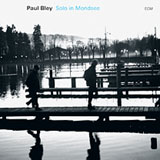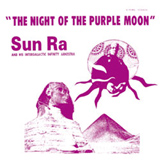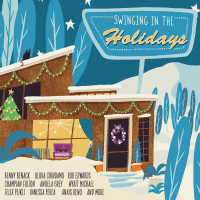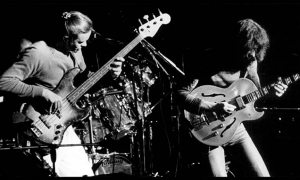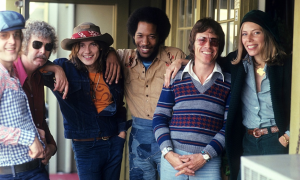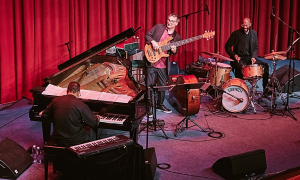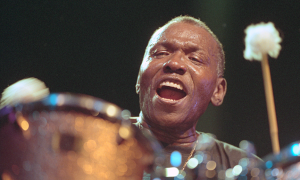Home » Jazz Articles » Profile » Duck Baker: Spinning Song
Duck Baker: Spinning Song
To me if I listen to some mountain musician like that I hear the same cry as I hear in Ornette Coleman. It
 If you have to ask who Duck Baker is, don't beat yourself up. Not a fixture on the New York scene, this accomplished acoustic finger-picking guitarist, composer and improviser—who has devoted himself to free music, modern jazz, swing, blues, gospel, Appalachian fiddling, Irish and Scottish folk song and other influences that were absorbed within these borders—isn't known to everybody. Perhaps that's because all of his seemingly far-flung interests have made him difficult to classify or even identify. But that can be easily rectified.
If you have to ask who Duck Baker is, don't beat yourself up. Not a fixture on the New York scene, this accomplished acoustic finger-picking guitarist, composer and improviser—who has devoted himself to free music, modern jazz, swing, blues, gospel, Appalachian fiddling, Irish and Scottish folk song and other influences that were absorbed within these borders—isn't known to everybody. Perhaps that's because all of his seemingly far-flung interests have made him difficult to classify or even identify. But that can be easily rectified.Just head on over to New York's The Stone this month (August, 2007), where many of the links Baker has forged in his creative and geographic travels over the last thirty years will be on neat display. That creative convergence includes appearances by two long-time fellow adventurers and collaborators—Stone-inventor John Zorn, known for landscaping much musical terrain in surprising ways and the experimentally inclined guitarist Eugene Chadbourne. It was at Zorn's invitation that Baker is curating these first two weeks of August jazz performances, while Chadbourne takes over the reins for the rest of the month. But there will be many, many other players who, says Duck, "I picked up on my travels or in their travels...
Chadbourne and Baker will play together for the first time in thirty years in an acoustic and then an electric version of "Fencing, Zorn's game-themed composition that they originally did with Randy Hutton on guitar in 1978. This time Marc Ribot is the third man for these new renditions (Aug. 16). Electric bassist Timothy Dahl and guests will join all three of those reunited veterans in an improv night to benefit The Stone (Aug. 18).
Richard R. Baker IV was born in 1949 and was raised in Richmond, Virginia before he ever dreamed of becoming part of the San Francisco free jazz scene or ending up living in Italy or London, where he now resides. Like many of the youth of the era he grew up in, he was enthralled with rock 'n' roll and also blues. But that's where the comparison to anybody else ends. Influenced early on by his close association with local ragtime pianist Buck Evans, Duck (a childhood name that stuck) began to think about ways piano playing might apply to guitar.
Much that is crucial to Baker's ideas—and actual practice—flows from this single source: Buck Evans.
"He had this idea about American music being one kind of music. That there was basically no difference between these forms, explains Baker. "One of the terms people have used for jazz, that I really don't like, is 'American classical music,' because it seems to then set up the whole attitude, like, well, this is very serious music. And [implies] that music like blues and R&B and ragtime and bluegrass and old-time Appalachian music is not serious music. And to me the whole thing that's cool about jazz is that it's not supposed to have those kinds of attitudes. One reason I've always felt at home with real avant-garde musicians is they tend to have great big ears.
And he may have the biggest ears of 'em all. "Gerry Hemingway, the drummer, is supposed to be a big Delmore Brothers fan. One of those early country acts, these two brothers who sang over the radio in the '30s. And they're deep. But you wouldn't necessarily think of this guy who's playing with Anthony Braxton listening to them. But to me it makes perfect sense. To me if I listen to Roscoe Holcombe or some mountain musician like that I hear the same cry as I hear in Ornette Coleman. It's exactly the same, to me there's no difference. If I hear Cecil Taylor I hear that as the same music.
But the Buck Evans connection from his youth is rooted even deeper than philosophy, much as that seems to steer his life. As with any great musician, what matters too is the practice. And Baker practices what he believes.
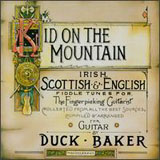 His fascination with the ragtime pianist of his youth radiates out to affect the way he plays and what he plays. "Because I developed playing blues, ragtime, I use a style that depends heavily on independent bass lines, says Baker, explaining how his approach departs from those of other finger-style jazz guitarists. "What a player like Joe Pass will do when improvising solo is often to play a very complex melody line and occasionally punctuate with bass notes or chords, somewhat along the lines of what a bop pianist does with his/her left hand. That's very cool but it's hard for me to think that way.
His fascination with the ragtime pianist of his youth radiates out to affect the way he plays and what he plays. "Because I developed playing blues, ragtime, I use a style that depends heavily on independent bass lines, says Baker, explaining how his approach departs from those of other finger-style jazz guitarists. "What a player like Joe Pass will do when improvising solo is often to play a very complex melody line and occasionally punctuate with bass notes or chords, somewhat along the lines of what a bop pianist does with his/her left hand. That's very cool but it's hard for me to think that way.
"The approach used for playing ragtime is to keep a bass pattern similar to stride pianists' left hand boom-chick accompaniment going and I taught myself to improvise swing melody lines over these bass patterns. Then I eventually learned how to improvise over other kinds of bass lines that suited more modern music.
Born out of that early correspondence between piano and guitar was a passion that continues to this day, culminating with his twin interests in capturing the composing and playing styles of Thelonious Monk and Herbie Nichols on guitar. All this will be embraced at The Stone. After all, it was Zorn who originally encouraged him to arrange Nichols' music for guitar, the result an extremely well-regarded recording called Spinning Song: Plays the Music of Herbie Nichols (Avant, 1996), which Zorn produced.
Wrestling with Nichols was even more demanding than trying to adapt Monk for guitar, though both presented challenges. "I had always wondered why jazz musicians never played any Herbie Nichols tunes, except for 'Lady Sings The Blues.' But as soon as I got hold of some charts and started working on it I found out right quick why they weren't playing him.
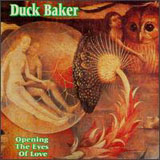 "Monk is more spare and Nichols tends to use richer kinds of chords that are harder to imitate on the guitar. Monk, once you've figured out what it is, it's not as much of a stretch to find a way to play it on guitar. Sometimes Monk is only using three notes, which is about what you'd normally do playing finger-style guitar...playing three or four notes.
"Monk is more spare and Nichols tends to use richer kinds of chords that are harder to imitate on the guitar. Monk, once you've figured out what it is, it's not as much of a stretch to find a way to play it on guitar. Sometimes Monk is only using three notes, which is about what you'd normally do playing finger-style guitar...playing three or four notes.
"The other thing is that Monk's progressions generally speaking don't deviate so far from swing and standard progressions. Sometimes they go into really deep things and very strange things and you're not even sure what key things are in, but the majority of his tunes don't do really weird things whereas the majority of Nichols' tunes do. And with Nichols, just the chord progressions themselves, even for tunes that he wrote back in the 1940s, are challenging in the extreme.
Got that?
Maybe you did. But the rest of us may have to be content to sample the results of Baker's explorations when he reveals his Monkish tendencies (Aug. 4), as well as his strenuous and sensitive tackling of Nichols' music in a solo guitar performance (Aug. 10).
Selected Discography
Duck Baker, Do You Know What It Means to Miss New Orleans (Day Job, 2005)
Duck Baker, Spinning Song: Plays the Music of Herbie Nichols (Avant, 1996)
Duck Baker, Art of Fingerstyle Jazz Guitar (Kicking Mule-Shanachie, 1980)
Duck Baker, The King of Bongo Bong (Kicking Mule, 1979)
Eugene Chadbourne, Guitar Trios (Parachute, 1977)
Duck Baker, There's Something for Everyone in America (Kicking Mule, 1976)
Photo Credit
Courtesy of Duck Baker
Tags
PREVIOUS / NEXT
Support All About Jazz
 All About Jazz has been a pillar of jazz since 1995, championing it as an art form and, more importantly, supporting the musicians who make it. Our enduring commitment has made "AAJ" one of the most culturally important websites of its kind, read by hundreds of thousands of fans, musicians and industry figures every month.
All About Jazz has been a pillar of jazz since 1995, championing it as an art form and, more importantly, supporting the musicians who make it. Our enduring commitment has made "AAJ" one of the most culturally important websites of its kind, read by hundreds of thousands of fans, musicians and industry figures every month.


